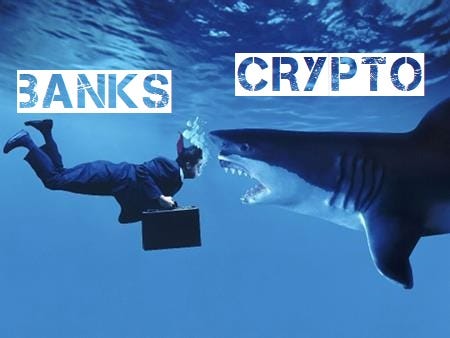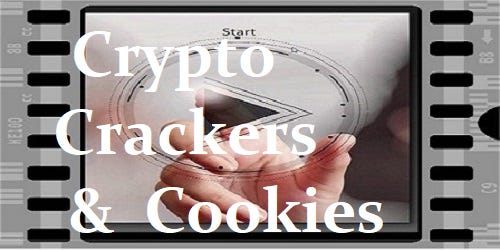Crypto Dummy - Beginner's Guide
Digital Ledger Technology - Cryptocurrencies Explained
Part 1 - The New Financial System
Part 2 - The Central Banks
Part 3 - Tokenization
Part 4 - The Crypto Exchanges
Definitions are for brevity and simplicity to explain things more easily; any dates are general for same.
The digital industry is growing so fast that it is difficult to track all innovations, especially for a beginner. Information here will be updated regularly.
Part 1 - The New Financial System
DeFi
Decentralized Finance (not requiring a centralized institutional bank - can be exchanged person-to-person).
The basic difference between crypto and how we use money today is that crypto's decentralized nature removes the need for financial intermediaries. But the Central Banks still want to be in control (see CBDC’s).
In the current system we can make a cash transaction, or we can use a credit/debit card. DeFi will be digital only - no writing checks, no cash. There is a justifiable concern that this new technology might lead to our enslavement under a full surveillance control system.
DLT (Digital Ledger Technology) (example: the Ripple Network)
A digital ledger showing every transaction using digital tokens (a long string of characters representing each transaction for every token). A transparent accounting - proof of every exchange of value on the ledger.
Proof of Consensus
Proof of Consensus is different than Proof of Work (see PoW - Proof of Work under Blockchain below)
No need for mining; all tokens are created already (pre-allocated) and validated by a de-centralized system of computers set up as nodes. Nodes are set up on computers all over the world to reach consensus through a delegated proof-of-stake (dPoS) system. Transactions are validated by a growing number of validating participants.
Digital Tokens will be used (see Tokenization below) as a store of value in the new financial system - they will facilitate the movement of money all over the world without the need for Nostro/Vostro accounts (holding money in escrow as proof of value for each transaction).
Nostro/Vostro - a globally established system of escrow accounts that currently hold the funds necessary to prove a credit/debit card transaction is covered.
The trillions of dollars held in Nostro/Vostro accounts in every country will be unnecessary. The Digital Ledger will provide the ODL (On-Demand-Liquidity) for each transaction. Transactions will validate immediately (as fast as sending a text message anywhere) and at a fraction of the current cost to move money.
ODL (On-Demand-Liquidity)
Proof of value (the liquidity) for cross-border payments - providing instant settlement, using DLT (Digital Ledger Technology) to send payments globally and nearly instantly and for a fraction of the cost.
The world will come to agreement on a global value for all transactions. An agreed upon Standard.
SWIFT - The Swift system, in use since 1973, is antiquated technology and very expensive and slow (global transactions taking days to complete compared to seconds) in contrast to ODL (On-Demand-Liquidity).
SWIFT is a messaging network, not a financial institution. It transfers value using multiple messaging systems that take time to connect. The transfer can take anywhere between one and five days. A lot of factors influence the speed of the transaction — intermediaries, holidays, Anti Money Laundering procedures, etc.
The term SWIFT stands for "Society for Worldwide Interbank Financial Telecommunication".
ISO 20022:
ISO 20022 is the new chosen messaging system - Instead of using multiple disconnected messaging systems to facilitate moving the value of money, the whole world will operate on a level playing field; every central bank will be using one single global electronic messaging system named ISO 20022.
We will see the tokenization of everything; money, real estate, business contracts, trading platforms, etc. (it's not just for currencies).
More ISO 20022 information will be added here as this article gets updated.
Part 2 - The Central Banks
CBDC's
CBDC Central Bank Digital Currencies
Central banks do not want to give up their control of the global financial system - they will not simply turn it all over to the citizens for peer-to-peer (person-to-person) transactions.
Central Bank Digital Currencies are being created by the central banks to represent each individual central bank currency to be used on the digital ledger for global and local transactions. Each transaction will be validated by a bridge currency using ODL (On-Demand-Liquidity).
Timeline:
Since 2019, this network has been set up, tested and is ready to go. The banks will not begin using the new system until the value of the token increases to represent the value necessary to facilitate global trade. In fact, as of November 2022 all banks are being required to get set up to use the new system, and to be in compliance by the end of March 2023 - now pushed forward into 2024.
As more time becomes necessary it is only because bureaucracies move like poured molasses.
The new financial system will run on this new technology.
Ripple - is the company (USA company that developed the technology for cross-border payment solutions - ODL (On-Demand-Liquidity).
XRP - is the token representing the value.
Stellar - is also a company (USA company that developed its own digital ledger and currently in use for person-to-person payments all over the world).
XLM - (known as Stellar Lumens) is the token representing the value.
Stellar Lumens, is an open source, decentralized protocol for digital currency to fiat money low-cost transfers which allows transactions between any pair of currencies.
XTC - (Xinfin; pronounced Zin-fin) is one example of a technology which will facilitate cryptocurrency trading software in the marketplace. Smart contracts create verification and transfer of title ownership to help combat fraud prevention.
Out of the tens of thousands of digital tokens and products that have been created since 2009, there are only a handful that will find a use case in the new financial system. Less than a dozen have developed use cases so far that can be implemented.
Watch crypto crackers & cookies to help you better understand how XRP & XLM are being implemented:
Part 3 - Tokenization
Cryptocurrencies or virtual currencies are denominated into tokens, which reside on their own blockchains.
Blockchains are special databases that store information in blocks that are then chained or linked together. This means that crypto tokens, which are also called crypto assets, represent a certain unit of value.
Cryptocurrencies are systems that allow for secure payments online which are denominated in virtual tokens. These tokens are represented by ledger entries.
Different tokens have been created by enterprising individuals and companies representing developing technologies - each with their own purpose for solving specific problems and facilitating this new system for tokenizing everything around the world.
In contrast to the blockchain using DLT (Digital Ledger Technology) there is another blockchain.
Blockchain - an electronic ledger created in 2009 using bitcoin tokens.
This Proof of Work (PoW) Bitcoin blockchain requires mathematical mining (using increasingly massive amounts of electrical energy to solve increasingly difficult mathematical equations - each miner receives tokens for their efforts and requires expensive setups of computer networks that must run constantly).
Examples of Proof of Work tokens are Bitcoin (BTC), Etherium (ETH), litecoin (LTC) and Dash (DASH). Other example of blockchain digital currencies include privacy-focused digital currencies such as Monero (XMR), Zcash (CEZ) and PIVX (PIVX), which allow users to make financial transactions online with varying degrees of anonymity and transactional privacy.
Part 4 - The Crypto Exchanges
Where Do I Buy This Stuff?
Crypto Exchanges - Online exchange trading platforms have been created to connect traditional banks to the Digital Ledger and blockchain so digital tokens can be purchased and exchanged. Most Crypto Exchanges also include a trading platform (similar to trading stocks using traditional currencies).
Tokens can be purchased on cryptocurrency exchange platforms at whatever is their current price. The price will be formed based on supply and demand in the crypto marketplace.
Where Do I Store This Stuff?
Crypto Wallets
This very important section will be added after further investigation! There is much to learn about the security and holding of crypto tokens. Secure your wealth.
Crypto wallets store your private keys, keeping your crypto safe and accessible. They also allow you to send, receive, and spend cryptocurrencies.
The main types of wallets include:
Paper wallets: Keys are written on a physical medium like paper and stored in a safe place. This of course makes using your crypto harder, because as digital money it can only be used on the internet.
Hardware wallets: Keys are stored in a thumb-drive device (you alone hold the keys to your crypto stored in this off-line device) that is kept in a safe place and only connected to a computer when you want to use your crypto.
Online wallets: Keys are stored in an app or other software – look for one that is protected by two-step encryption. This makes sending, receiving, and using your crypto as easy as using any online bank account, payment system, or brokerage. But your crypto keys may still be at risk from internet hackers.
Crypto wallets technically don’t store your crypto. Your holdings live on the blockchain or a digital ledger, but can only be accessed using a private key. Your keys prove your ownership of your digital money and allow you to make transactions. If you lose your private keys, you lose access to your money.
Follow my substack: subscribe to get further updates for securing your future in the new financial system.




